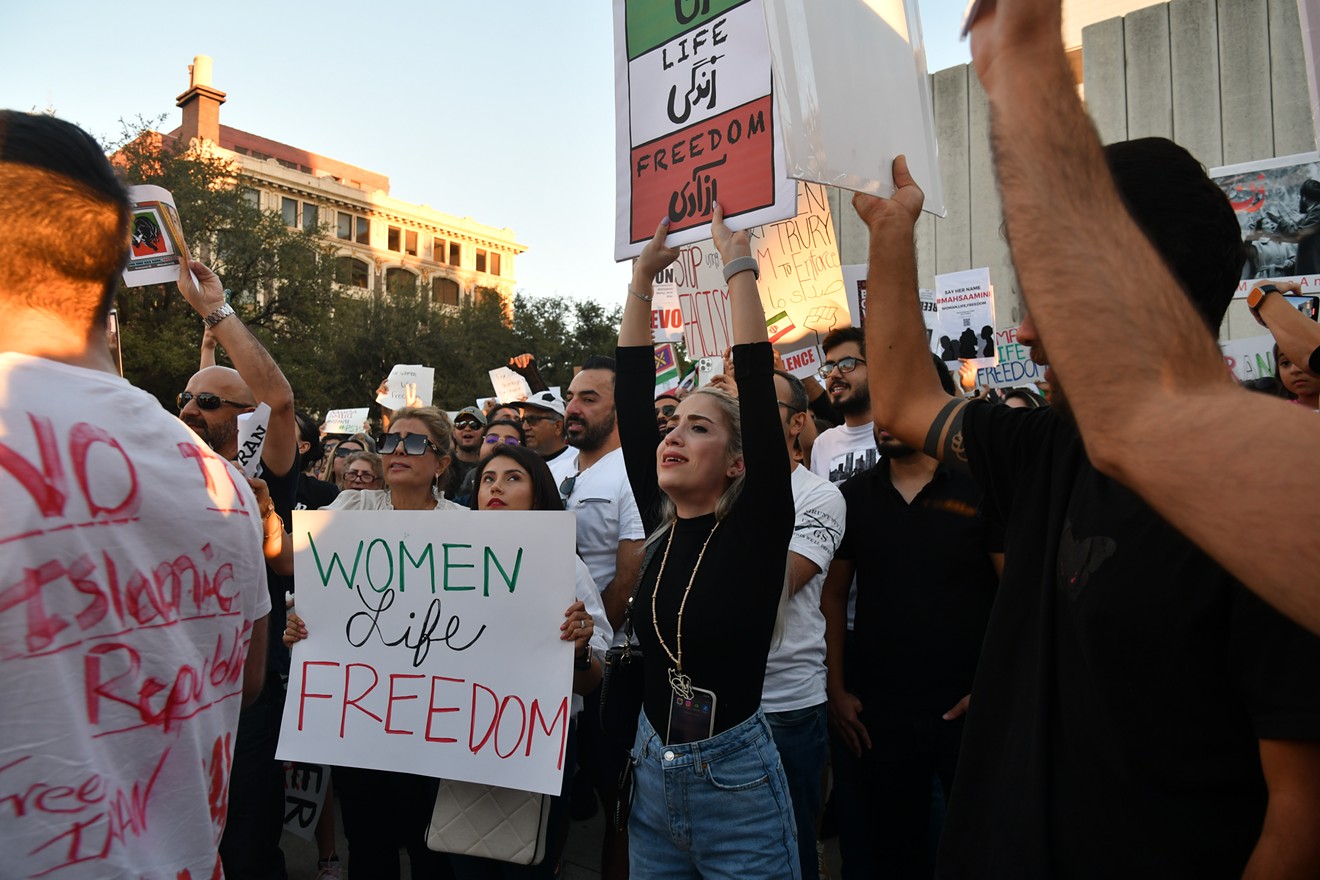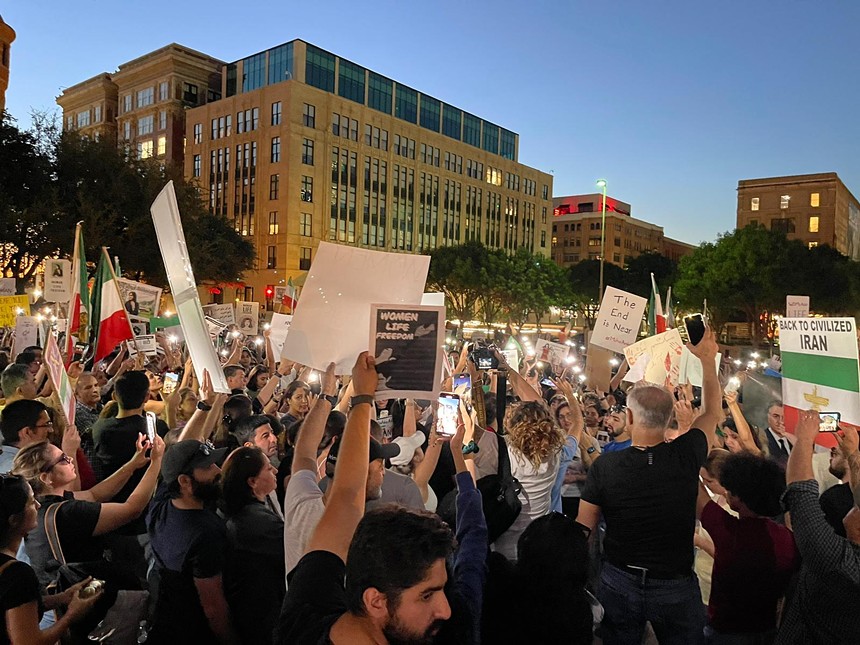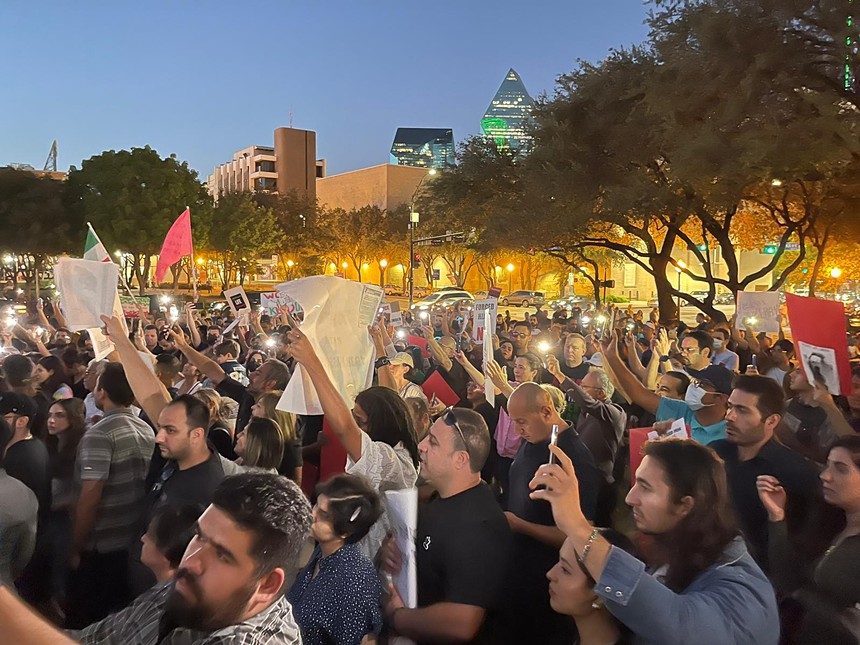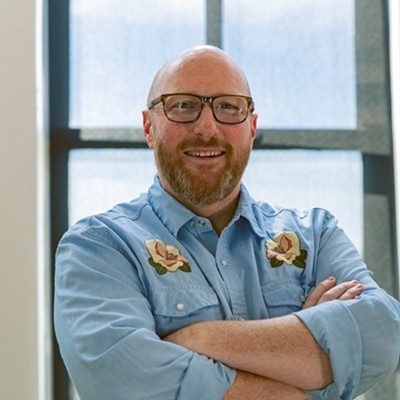On the same day, half a world away in the Iranian capital of Tehran, marches were also taking place. Swarms of protesters shouted “Death to the dictator” and chanted “Freedom! Freedom! Freedom!” and “College students rather die than live in infamy.”
Similar dramatic scenes have played out recently in Berlin, Los Angeles and London, among many other major cities. Along with the Greenville Avenue gathering, several well-attended demonstrations took place in North Texas as October rolled into November.
Aside from the nature of the messaging, there’s another uniquely specific element to the signage among the throngs and these protests aimed at the Iranian government: the name Mahsa Amini.
Amini, 22, died in a Tehran hospital on Sept. 16 after being detained by Iran’s guidance patrol, often referred to as the morality police. Amini, who also went by Jina, was taken into custody for allegedly violating the hijab rule, the Muslim edict requiring women to cover their heads with a scarf, as she visited the capital city along with her family.
The Iranian government has stated Amini died after suffering a heart attack while in custody, but her family and much of the Iranian population dispute that claim and are convinced her death was something much more brutal. Pictures and video show Amini in a hospital bed with bruising to her face and bleeding from her head, suggesting she endured a significant amount of physical trauma after she was arrested.
As word of Amini’s death spread around Tehran, protests rang out with impressive strength and efficiency. Many of the women marching made a point to not cover their heads, and in some cases they cut their hair in another defiant act against what they see as their government’s repeated oppression of them.
Iranian forces descended upon the crowds, initiating a ferocious crackdown that would continue for days, resulting in numerous beatings and shootings, thousands of arrests and a reported 17 deaths in the span of a single week. By Nov. 14, following almost two months of protests, more than 300 people had died during the demonstrations, as Iran announced it had sentenced an unnamed protester to death for their alleged role in a government building fire during a protest.
Amnesty International says that many more protesters are in danger of being sentenced to death by the Revolutionary Courts in Tehran for their roles in the uprising. It has also been reported that 58 children, some of them as young as 8, have been killed by police since the protests began.
The images, videos and headlines have stoked the passions of Iranians around the world, as well as the global media and the public in a way that’s reminiscent of the famed Arab Spring of more than a decade ago. Protests directed at the Iranian government are certainly not a new thing, with widespread protests taking place on a fairly regular basis.
Recent examples include the 2020 “Bloody November” demonstrations, which targeted a drastic rise in fuel costs. In 2009 and 2010, protests in support of opposition presidential candidates saw a great number of arrests and deaths. With each new movement, it seems as though the public grows more vocal even as the government, now led by President Ebrahim Raisi, remains viciously oppressive.
This Time It’s Different
In North Texas, protests began within days of Amini’s death. On Sept. 25, hundreds, many carrying Iranian and U.S. flags, met at Dealey Plaza near the John F. Kennedy memorial to bring awareness to what was happening in Iran. Niloo Jalilvand, a retired teacher at Booker T. Washington High School for the Performing and Visual Arts, has helped organize some recent protests locally. She says what’s happening now isn’t like what has happened in the past.“It is different this time,” she says. “It’s different this time because for the first time ever, it is a truly feminist revolution, with the support of the men. When you see footage of the protests, you see groups of girls at the front with guys behind them. I give so much credit to Gen Z, too. Gen Z wants to change the world.”
Jalilvand has watched her former home descend into violence as the regime’s stronghold has strengthened over the past 40 years. As a child she came to America with her family, fleeing Iran as Ayatollah Ruholla Khomeini rose to power in 1979.
As a teenager, she was greeted by a “No Iranians Allowed” sign at a burger joint in Commerce, Texas a signifier of the anti-Iranian sentiment felt throughout much of America in the wake of the Iranian hostage crisis. In an encouraging turn that served as a good omen for her life in her new home, Jalilvand says her family and the family that ran that restaurant became friends.
A report from the U.S. Census Bureau indicates there are 11,000 residents in the Dallas/Fort Worth/ Arlington area who were born in Iran. To Jalilvand, the decades since her arrival have shown her there’s a vibrant Iranian population in North Texas — one that believes it has a responsibility to those still living in Iran to make sure the world doesn't forget them.
“The government there does not care about anybody,” she says. “Our goal with these protests here in Dallas is to amplify the voices of the fighting women and men in Iran. They have become martyrs. These are 16-, 17-, 18-year-olds that are fighting and dying. Women are being imprisoned and raped as their punishment. They’re political prisoners and some of them are awaiting execution. We don’t want them to die in vain.”
Moving Beyond Painful Memories of the Past
A 33-year-old data scientist and Denton resident, who wishes to remain anonymous because she fears for her family’s safety in Iran, was hit hard by the news of Amini’s death. A recent graduate of the University of North Texas, she’s been in America only a few years, so her own experiences with the Iranian authorities were fresh in her mind.“Finding out about Mahsa’s death and the protests immediately triggered memories I have of the Ghast, the morality police,” she says. “I’ve been through so much over there simply because I am a woman and someone else controls my outfit.”
In the days that followed Amini’s death, the data scientist found herself fixated on what was going on in Iran. Her coworkers even noticed she was distracted, but she was not aimlessly inattentive. She was indeed focused, but not on her workplace.
“My mind kept going back to my past in Iran,” she says. “And I realized that since I’ve been in America for a few years now I needed to have courage. I asked myself, ‘If I were still in Iran, I wouldn't want to remain silent, so why should I stay silent here?’”
That epiphany struck at a key moment. Iran’s president was scheduled to address the United Nations on Sept. 21, and that left enough time for her to book a flight to New York City and join the protests that would precede Raisi’s appearance. Even as she began to take action, she had to train herself to not fear for her safety after simply speaking out.
“I kept telling myself, I won’t be arrested here for saying something,” she says. “That wasn’t a threat, so not only would I not stay silent, I wasn’t going to stay in Texas when I knew the U.N. was going to let the president of Iran speak to so many world leaders.”
Some friends warned her that organized demonstrations even in America can become violent. But more than that, she found galvanizing encouragement from many others who wanted to shine a light on the atrocities Iran’s government continues to inflict on its own people. Besides, she had always wanted to visit New York. What better reason to make her first trip there than this?
During the United Nations protest the data scientist found inspiration. She had helped tell the global leaders of the U.N. that Raisi isn't welcome here, and just as Jalilvand said, the data scientist felt that Iranians here in America “needed to be the voice of the people in Iran.”
But deep-seated fears and behaviors are tough to shed. The data scientist was in a sea of people, thousands of miles from her old home. But because she was lifting her voice against a government that doesn’t allow such things within its borders, she found herself being more cautious than she had originally intended to be.
She wore a mask, sunglasses and a hat to conceal her identity and found safety in that. But again, she questioned herself. What good is her freedom from persecution, from the morality police, from the hijab rule, if she wasn’t ready to be both vocal and uncovered?
She has parents, siblings, nephews and nieces still in Iran, and without regular communication with them, she’s left only to hope they’re safe. She’s in America, away from the fighting, but she doesn’t feel helpless.
She shows her face when protesting now, but doing that is more of a personal risk for her, not something that might endanger her loved ones in Iran. She says she’s a bit nervous being interviewed for this article, but she thinks about the bravery of the girls who are taking to the streets of Tehran, burning their hijabs, risking their lives, so she moves past her nerves.
“When I got back from New York, I could feel that, this time, things were different,” she says. “We all felt like this wasn’t going to end after two or three days.”
She was right about that. In the past two months, she has taken part in several protests, ranging from a few dozen people to hundreds and even more in the Dallas area. No mask, no hat, no glasses. She’s one of the many who paint the words “Women Life Freedom” on their skin when marching.
“I wanted to be myself,” she says. “And our protests haven’t been like other protests I was warned about. There has been art, singing and dancing.”
A Hope for Lasting Change
When it comes to the aim of the protests, the data scientist says there is a specific message, even beyond the outrage over Amini’s killing.“We’re asking for basic human rights,” she says. “In Iran, women cannot sing. Women cannot ride a bike. We can’t go to a stadium where other men are. We can’t leave the country without our father’s or husband’s permission. A woman in Iran just exists, but she doesn’t really live life.”
When it comes to their Iranian homeland, Jalilvand and the data scientist believe that if powers outside the Middle East fail to put pressure on Raisi, there’s little reason for Iran to change anything. The hope that the protests here in America can pressure Western powers out of their silence is a driving force for their demonstrations.
Positive change in a country such as Iran, a land that’s arguably grown only more intolerant of its citizens, isn’t a wheel easily turned. The data scientist says that even as she learns of the horrors befalling those who are taken into custody, she has hope that a brighter day will appear sooner rather than later.
“You can put people in jail,” she says. “But you can’t take away their hope. If I had no hope, I wouldn’t be talking to you. There are people in Iran right now going into the streets, knowing they will be arrested or even killed, but they go out there because they have hope.”














